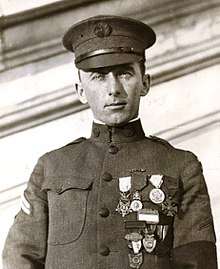John L. Barkley
John Lewis Barkley (August 28, 1895 – April 14, 1966) was a United States Army Medal of Honor recipient of World War I. Born in Blairstown, Missouri, near Holden, Barkley served as a Private First Class in Company K, 4th Infantry Regiment, 3rd Division. He earned the medal while fighting near Cunel, France, on October 7, 1918. His autobiography, "Scarlet Fields: The Combat Memoir of a World War I Medal of Honor Hero," details his service leading up to and following his Medal of Honor action.[1] The book draws comparisons as the American literary response to "All Quiet on the Western Front." Barkley died in 1966, and is buried in Forest Hill Cemetery, Kansas City, Missouri.[2]
John Lewis Barkley | |
|---|---|
 Medal of Honor recipient | |
| Born | August 28, 1895 Kansas City, Missouri |
| Died | April 14, 1966 (aged 70) |
| Place of burial | Forest Hill Cemetery, Kansas City, Missouri |
| Allegiance | |
| Service/ | United States Army |
| Years of service | 1917 - 1919 |
| Rank | Corporal |
| Unit | Company K, 4th Infantry Regiment, 3rd Division |
| Battles/wars | World War I |
| Awards | Medal of Honor |
Medal of Honor citation
Rank and organization: Private First Class, U.S. Army, Company K, 4th Infantry, 3rd Division. Place and date: At Cunel, France; October 7, 1918. Entered service at: Blairstown, Missouri. Birth: August 28, 1895; Blairstown, Missouri. General Orders: War Department, General Orders No. 44 (April 2, 1919).
Citation:
- Private First Class Barkley, who was stationed in an observation post half a kilometer from the German line, on his own initiative repaired a captured enemy machinegun and mounted it in a disabled French tank near his post. Shortly afterward, when the enemy launched a counterattack against our forces, Private First Class Barkley got into the tank, waited under the hostile barrage until the enemy line was abreast of him and then opened fire, completely breaking up the counterattack and killing and wounding a large number of the enemy. Five minutes later an enemy 77-millimeter gun opened fire on the tank pointblank. One shell struck the drive wheel of the tank, but this soldier nevertheless remained in the tank and after the barrage ceased broke up a second enemy counterattack, thereby enabling our forces to gain and hold Hill 25.[3]
Military awards
Barkley's military decorations and awards include:
| 1st row | Medal of Honor | World War I Victory Medal w/ one silver and one bronze service star
|
Médaille militaire (French Republic) | ||||||
|---|---|---|---|---|---|---|---|---|---|
| 2nd row | Croix de guerre 1914–1918 with bronze palm (French Republic) |
Croce al Merito di Guerra (Italy) |
Medal for Military Bravery (Kingdom of Montenegro) | ||||||
References

- John L. Barkley, "Scarlet Fields: The Combat Memoir of a World War I Medal of Honor Hero"
- "John L. Barkley". Claim to Fame: Medal of Honor recipients. Find a Grave. Retrieved 2009-06-21.
- "Medal of Honor recipients". Medal of Honor for World War I. United States Army Center of Military History. June 8, 2009. Retrieved 2009-06-29.
External links
- "Medal of Honor, John L. Barkley". Retrieved September 29, 2010.
- "Medal of Honor citations". Medal of Honor recipients, John L. Barkley. United States Army Center of Military History. August 3, 2009. Retrieved July 1, 2010.
- Trout, Steven: Barkley, John Lewis, in: 1914-1918-online. International Encyclopedia of the First World War.